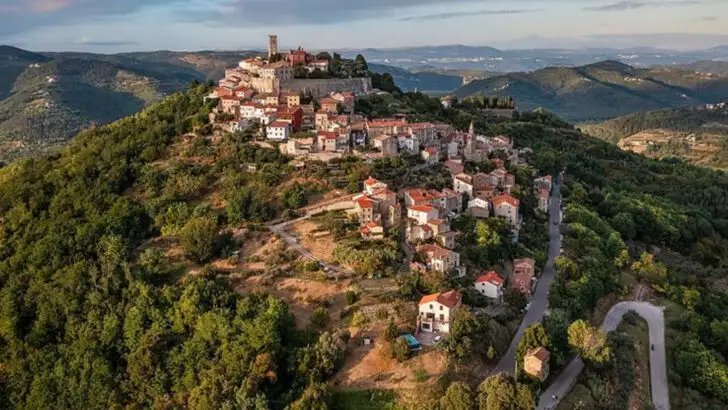Along Croatia’s Adriatic coast, the line between past and present feels almost invisible. Walled towns, cobblestone streets, and ancient fortresses rise above the sea, telling stories of trade, battles, and empires that shaped the Mediterranean. Every corner seems to whisper centuries of history written in stone.
These 10 medieval towns capture the essence of Croatia — where sunlit harbors meet Gothic towers, and time seems to slow between the sound of waves and the toll of old church bells.
Dubrovnik
Dubrovnik charms with its imposing city walls, standing tall against the azure of the Adriatic. Often referred to as the “Pearl of the Adriatic,” this city is a preserved medieval masterpiece. Its streets, lined with limestone, echo tales of a rich history.
The city’s fortifications, some dating back to the 12th century, create a majestic skyline. Stroll through Stradun, the main street, and imagine the vibrant merchant life of the past.
Dubrovnik’s blend of Gothic, Renaissance, and Baroque architecture captivates visitors. It’s no wonder it has inspired filmmakers and artists alike.
Trogir
Trogir’s charm lies in its narrow cobblestone streets and historical allure. As a UNESCO World Heritage Site, it showcases a mix of Romanesque and Renaissance architecture.
The Cathedral of St. Lawrence stands as a testament to artistic genius, particularly the Radovan Portal. Enjoy wandering the labyrinthine alleys that reveal hidden courtyards and quaint cafes.
This small island town, linked by bridges, boasts a rich tapestry of culture. Its Venetian style is reminiscent of a bygone era, making every corner a picture-perfect moment.
Šibenik
Šibenik reveals its splendor through the Cathedral of St. James, a stunning example of Renaissance architecture. This masterpiece is famed for its unique construction entirely in stone.
The city’s fortresses offer panoramic views, telling tales of battles fought to protect its shores. St. Michael’s Fortress, particularly, has become a cultural venue.
Šibenik’s charm isn’t confined to its buildings. Its vibrant arts scene and lively festivals bring a dynamic vibe to the historic setting, blending past and present seamlessly.
Korčula
Korčula is often whispered to be the birthplace of Marco Polo, adding mystery to its medieval streets. The old town, shaped like a fishbone, is a maze of narrow lanes.
Gothic and Renaissance buildings are adorned with intricate stonework, with St. Mark’s Cathedral as the crown jewel. Its bell tower provides sweeping views over the sea.
Korčula’s rich cultural heritage is celebrated with traditional knight dances, ensuring that history remains alive in this enchanting island town.
Rab
Rab boasts four iconic bell towers, creating a distinctive skyline against the shimmering sea. Its medieval streets are a delight, filled with Gothic and Romanesque architecture.
The town’s history dates back to Roman times, evident in its archaeological remnants. Each summer, Rab comes alive with the Medieval Festival, a vibrant celebration of its past.
Known as the “Happy Island,” Rab offers a mix of history and relaxation, with pristine beaches complementing its cultural treasures.
Nin
Nin captivates with its Church of the Holy Cross, earning the nickname “the smallest cathedral in the world.” This tiny church reflects early Croatian religious architecture.
The town, once the seat of Croatian kings, is rich in history and charm. Stroll along its ancient stone bridge to explore remnants of Roman temples.
Nin’s salt pans, still in operation, add another layer to its allure. The blend of natural beauty and historical significance makes Nin a true gem.
Motovun
Motovun invites with its hilltop position, offering panoramic views of Istria. This medieval town is encircled by 13th-century walls that guard its cobbled streets.
Famed for its annual film festival, Motovun merges culture with history amidst a backdrop of vineyards and truffle-rich forests. The town’s Venetian influences echo in its architecture.
A walk along the walls reveals breathtaking vistas. Each stone here seems to whisper tales of knights and noble families who once called it home.
Poreč
Poreč captivates with the Euphrasian Basilica, a UNESCO World Heritage Site celebrated for its intricate mosaics. This 6th-century church stands as a masterpiece of Byzantine art.
The town’s Roman roots are visible in its street layout and ancient ruins. Each corner holds a fragment of history, from Venetian houses to Gothic palaces.
Poreč offers more than its past. A lively marina and vibrant cultural scene provide a perfect blend of old and new, inviting exploration beyond its historical core.
Ston
Ston is renowned for its impressive walls, often dubbed the “European Great Wall.” These 5-kilometer-long fortifications were built to protect valuable salt pans.
The town’s strategic importance is evident in its well-preserved medieval streets and gates. Ston is also famous for its oysters, a delicacy enjoyed since Roman times.
Nature and history blend seamlessly here. Hiking along the walls offers breathtaking views of the Adriatic and surrounding countryside, making Ston a unique coastal retreat.
Cres
Cres enchants with its medieval streets that wind through an old town filled with Venetian influences. This island town offers a tranquil escape with a rich historical tapestry.
The town’s stone houses and narrow alleyways lead to hidden squares where time seems to slow down. Cres is also a sanctuary for the rare griffon vulture, a symbol of its natural beauty.
History and nature coexist, creating an enchanting landscape where the Adriatic Sea meets ancient stone. Cres invites those seeking a peaceful yet culturally rich experience.

